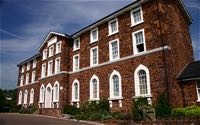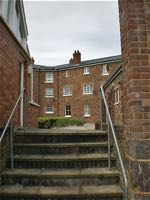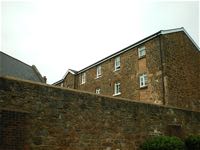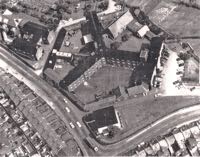
Redhills Workhouse and Hospital
aka St Thomas Union Workhouse
Page updated 2nd November 2016
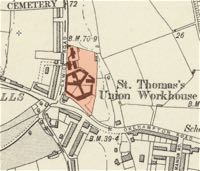 This former workhouse and then hospital still
stands, almost proudly, on the corner of Exwick and Okehampton Roads.
This former workhouse and then hospital still
stands, almost proudly, on the corner of Exwick and Okehampton Roads.
Before 1899, St Thomas was responsible for its own administration. Therefore, the St Thomas Poor Law Union was formed on 21st April 1836 to administer poor relief over a wide area of 49 parishes including Alphington, Exmouth, Heavitree and Woodbury, to be overseen by a Board of 61 Guardians.
A new workhouse was built at Redhills in 1837, on the border of St Thomas and Exwick to accommodate 450 inmates. The architect was Sampson Kempthorne, who designed many other workhouses in Devon, and it covered 3½ acres and cost £11,000 to construct. It had three wings, emerging like spokes from a hub, with each wing meeting at right angles a long block arranged around the hexagonal periphery. Each area between two three storey accommodation wings was divided into two exercise yards. Sometime later, a hospital block was built north of the main complex, on the Exwick Road known as the Victoria Block, and a second Albert Block dating from 1897.
The workhouse had its own well which was sunk in 1837. Luckily, a worker escaped injury when the well collapsed.
A well sinker, at the new union workhouse, in Thomas's, had a narrow escape of his life Monday. He was working at a depth of 30 feet, when the upper part—twelve feet of which is bricked, gave way—and for several hours he remained buried beneath the mass of bricks and earth. His preservation was most providential and he was dug out uninjured. North Devon General 12 October 1837
The inmates were given a Christmas dinner every year, and the newspapers liked to let the citizens know how well they were treated.
ST. Thomas Union.—The inmates of this Union were well provided for, and on Monday sat down to a capital dinner, consisting of rounds of beef, roasted and stufled, roast pork, plum-pudding, and vegetables. The large hall in which the inmates have their meals was tastefully decorated with holly. From the ceiling hung many coloured paper lanterns. From the centre of it hung a crown, composed of evergreens, and around it were hung several figures ingeniously cut out of mangold wurtzel. ln the afternoon the inmates partook of tea and cake, and the rest of the evening was devoted to amusements. The whole passed off very pleasantly. Exeter and Plymouth Gazette - 30 December 1870
Of course, the reality of hard toil, and poor food, the rest of the year, was not mentioned.
In 1930, the Poor Law Union maintaining the Redhills Workhouse was abolished to be replaced by the Public Assistance Institution and then, in 1948, the workhouse was absorbed into the new NHS. The hospital block was used as a maternity facility during and after the Second War, and in the 1950's, the old workhouse became a geriatric hospital, and later a drop in centre for the elderly. In 1996 it was used as a day centre for mental patients for the Exeter Community Health Trust. The buildings have since been redeveloped for housing.
Sources: British Newspaper Archive
│ Top of Page │
